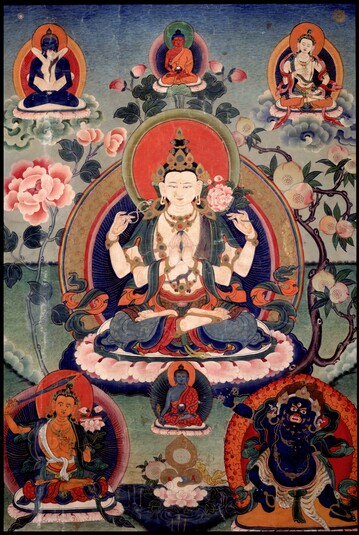
Item: Avalokiteshvara (Bodhisattva & Buddhist Deity) - Chaturbhuja (4 hands)
| Origin Location | Tibet |
|---|---|
| Date Range | 1900 - 1959 |
| Lineages | Buddhist |
| Size | 64.44x43.48cm (25.37x17.12in) |
| Material | Ground Mineral Pigment on Cotton |
| Collection | The Brooklyn Museum of Art |
| Catalogue # | acc. #BMA 69.164.8. Gift of Mr. and Mrs. Arthur Wiesenberger |
Alternate Names: Lokeshvara Avalokita Lokanata Lokanatha Mahakarunika
Classification: Deity
Appearance: Peaceful
Gender: Male
Avalokiteshvara, Chaturbhuja (Tibetan: chen re zi, chag shi pa. English: the All Seeing Lord with 4 Hands) surrounded by various Buddhas and Deities.
"As the nature of all buddhas, Avalokiteshvara, in colour like stainless conch and crystal, very resplendent, smiling, peaceful and radiant. With four hands the first are folded at the heart, the lower hold a crystal mala and jewelled lotus, two beautiful feet seated in vajra posture, adorned with many attractive silks and jewels, beautified with dark blue hair in tufts [some] loose. On the crown of the head, the wisdom of all buddhas, is the Lord, source of all refuge gathered as one, in essence the Guru in the aspect of Amitabha, in the manner of the Lord of the Family, seated happily." (Ngorchen Konchog Lhundrup 1497-1557).
Beautiful in appearance with one face, white of colour and four hands, he holds in the upraised right a string of beads made of crystal, in the upraised left a pink lotus blossom. The main pair of hands are folded at the heart cradling a blue wish-fulfilling jewel. A krishnasara deer skin hangs across the left shoulder. Gold and jewel ornaments adorn the body along with silks of various colour. A large red aureola surrounds the head and a blue nimbus ringed with multiple colours encircles the body.
"To the Lord unstained by faults, white in colour, the head adorned with the perfect buddha, gazing on beings with eyes of compassion; to Avalokiteshvara I bow." (The great Tibetan King Songtsen Gampo, 557-649).
At the top center is the Buddha Amitabha, red in colour, with the hands placed in the lap supporting a black begging bowl. At the left is the Buddha Samantabhadra, dark blue, naked, embracing the consort Samantabhadri. At the right is the meditational deity of purification, Vajrasattva, white, holding a vajra and bell.
At the lower center is the Medicine Buddha, blue, holding a healing plant in the right hand and a begging bowl in the lap with the left. To the lower left sits the bodhisattva Manjushri, orange in colour, with the right arm aloft holding a sword edged with orange and red flames of wisdom fire. The left hand at the heart holds the stem of a lotus blossoming at the left ear supporting the book - Prajnaparamita. Seated in vajra posture he is surrounded by a red aureola and a blue nimbus atop a moon disc and pink lotus blossom seat. At the right side is wrathful Vajrapani, blue, holding a vajra scepter upraised in the right hand and the left in a pointing gesture held to the heart. Surrounded by orange flames, he stands with the right leg bent and left straight atop a sun disc and pink lotus seat.
Avalokiteshvara is the patron deity of Tibet and as a meditational deity is practiced by all traditions of Buddhism. There are numerous Sarma traditions (Sakya, Kagyu and Gelug) of practice as well as different forms which span all four tantric classifications along with uncounted Kama and Terma (treasure) traditions from the Nyingmapa School.
Jeff Watt 3-2002
Buddhist Deity: Avalokiteshvara Main Page
Collection of Brooklyn Museum of Art
Collection of Brooklyn Museum of Art (Deities)
Buddhist Deity: Avalokiteshvara, Chaturbhuja - Four Hands - Main Page
